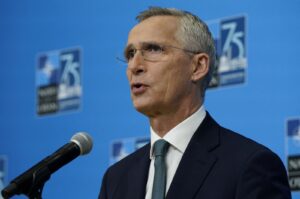As spring approaches, Russia is preparing for a significant military offensive aimed at strengthening its negotiating position in cease-fire discussions, according to Ukrainian government and military analysts.
This new offensive, set to unfold across the expansive 1,000-kilometer front line, signals a fresh effort by Russian President Vladimir Putin to prolong the conflict and delay any pause in hostilities, Ukrainian officials claim.
They argue that Russia’s true intention is not to engage in meaningful peace talks but to expand its territorial control.
Ukrainian President Volodymyr Zelenskyy, in a statement made during his recent visit to Paris, accused Putin of dragging out talks to “buy time” and gain a stronger position by seizing more land.
Zelenskyy cited intelligence reports indicating Russian forces are focusing their efforts on the northeastern regions of Sumy, Kharkiv, and Zaporizhzhia.
Two G7 diplomatic officials in Kyiv privately agreed with this assessment, underscoring that Russia’s strategy aims to prolong the war rather than seek peace.
Despite a U.S. proposal for an immediate 30-day cease-fire, Russia has effectively rejected the offer, complicating the prospects of any meaningful de-escalation.
This rejection, coupled with the Kremlin’s insistence on imposing significant preconditions – such as reconnecting Russia’s state bank to the SWIFT international payment system – has cast doubt on the potential for even partial agreements, such as a cease-fire in Black Sea shipping routes.
The situation on the ground is tense, with Russia launching fresh drone strikes on Ukrainian cities.
Last Friday, Dnipro was hit, resulting in four deaths and 21 injuries, while a missile strike in Kryvyi Rih, Zelenskyy’s hometown, injured at least five.
Amid these attacks, Putin remains confident, claiming that Russian forces hold the strategic initiative along the front line, steadily advancing and liberating new territories.
Military commanders in Ukraine report that Russia has stepped up attacks in recent weeks, positioning itself for a major offensive in the coming months.
Ukrainian military analyst Pavlo Narozhnyi stated that Russia is likely to need until May to solidify its position before launching a more extensive push.
The increasing reconnaissance missions and intensified fighting across various regions – particularly in Donetsk and Zaporizhzhia – suggest that Russia is preparing for a larger-scale offensive aimed at regaining more territory.
Particularly concerning for Ukrainian forces is the battle for Pokrovsk, a critical stronghold in the Donetsk region.
The city’s capture would bring Russian forces closer to achieving their objective of seizing the entire region.
Ukrainian commanders on the ground report heightened Russian reconnaissance activity and a significant buildup of troops and armored vehicles in surrounding areas, signaling that the enemy is preparing for a renewed assault.
As battles intensify, including a renewed offensive west of Orikhiv in Zaporizhzhia, Ukrainian commanders are growing wary of Russia’s ability to execute a multi-pronged attack, potentially spanning the next several months.
Ukrainian military analyst Oleksii Hetman predicts that Russia’s offensive actions could continue into 2025, putting even more pressure on Ukraine’s defenses.
Meanwhile, optimism within Russia’s military ranks is palpable.
Military analyst Sergey Poletaev believes that Russia’s army, despite facing weariness from prolonged combat, is well-positioned to achieve decisive victories in the coming months, potentially causing the collapse of Ukraine’s defenses.
With all eyes on the front lines and diplomatic negotiations faltering, Ukrainian soldiers remain uncertain about the direction of the conflict. “No one believes in them,” said a Ukrainian soldier with the call sign “Italian,” referring to the peace talks.
However, despite the grim outlook, there remains a sliver of hope that the situation on the battlefield may eventually shift, altering the course of the war.




















































Be First to Comment